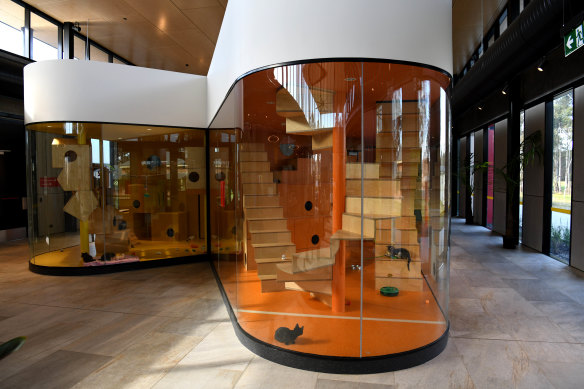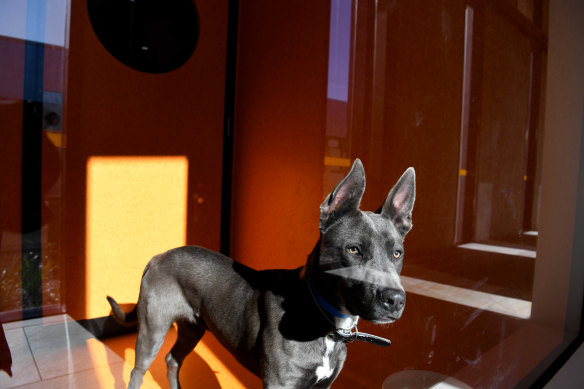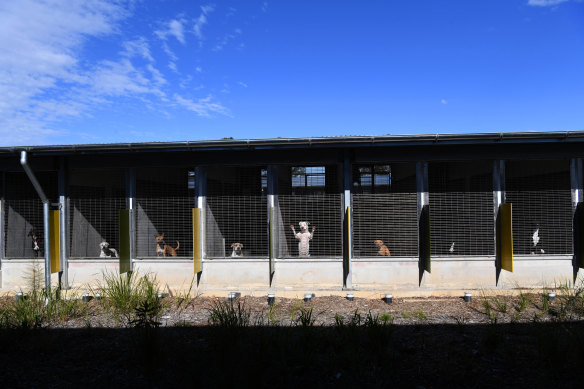By Julie Power
This isn’t like any pound most Australians would’ve visited.
Designed by the award-winning Sam Crawford Architects, the new $36 million Blacktown Animal Rehoming Centre (BARC) resembles a light and airy community centre, or a modern public library, only people are visiting to adopt a pet rather than borrow a book. It doesn’t smell, noise is at a minimum, and glass has mostly replaced wire.

The $36 million Blacktown Animal Rehoming Centre (BARC) features state-of-the-art facilities. Credit: Dean Sewell
As pounds and refuges across Australia deal with record numbers of abandoned animals, Blacktown mayor Tony Bleasdale says BARC will change the way facilities are designed and operated. “Everything we do seeks to improve the rehoming rates for pets,” he said at the centre’s opening on Sunday.
With 235 cat condos and 135 dog kennels, BARC is double the size of the council’s old pound, and it is now the largest facility of its kind in the Southern Hemisphere. Operating since March, it has cared for 387 abandoned dogs, 125 of which have been adopted, together with a similar ratio of cats.
Bleasdale says BARC will be a one-stop shop for domestic animal welfare.
It will “provide a home for good”. Potential pet owners will receive the concierge treatment to ensure they are educated about animals and matched with one that fits their lifestyle, with space to walk and play in homely areas.
Centres are so full that there are waiting lists to surrender animals. RSPCA NSW also says it is taking longer to find new homes for pets. It takes an average of 34 days, for example, for a dog to be adopted, twice as long as last October, and five times that of October 2020 during the COVID-19 pandemic.
With adoption rates lower and slower, some animals may be in care for months, even years, which increases the chances of behavioural challenges, a spokesperson for the RSPCA says.
NSW pounds, shelters and veterinarians say they have never seen so many pets being surrendered or abandoned. Many pets adopted during the pandemic have been surrendered, with owners saying they can no longer afford them because of the higher cost of living.
The founder of no-kill shelter Monika’s Doggie Rescue, Monika Biernacki, says the situation has never been more dire.
“Everyone is desperate,” she says. “The emails, the calls, are never ending. People can’t afford a pet, they are moving into an apartment, they talk of the economic crisis, and the euthanasia rate is higher than ever. All the rescue groups are full, full, full.”
Architect Sam Crawford has worked on the BARC project since 2015 and says the key was to improve animal welfare, so they are less likely to get sick or behave badly.
“Healthy and happy animals are more likely to move through BARC quickly and find homes,” Crawford says.
The state-of-the-art facilities, backed by research, were also designed to increase community acceptance and adoption of impounded animals, Crawford says.

“Healthy and happy animals are more likely to move through BARC quickly, and find homes,” says architect Sam Crawford.Credit: Dean Sewell
To identify best practices in animal welfare and design, Crawford and council staff studied and visited the best shelters overseas.
They also saw the worst – noisy and smelly facilities where distressed and sick dogs were locked in internal rooms without light or air and little human contact.
At the other end of the scale, in one United States facility, volunteers were reading to the cats and dogs. “It was about socialising them,” Crawford says.

With 135 dog kennels and 235 cat condos, the shelter is the largest facility of its kind in the Southern Hemisphere.Credit: Dean Sewell
He was pleased that BARC’s design has maximised the opportunity for rehabilitation and adoption of dogs and cats. The layout minimises distress, and helps with rehabilitation. It also makes the facility feel less like an institution, and more welcoming to visitors who want to adopt animals.
The Morning Edition newsletter is our guide to the day’s most important and interesting stories, analysis and insights. Sign up here.